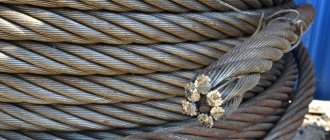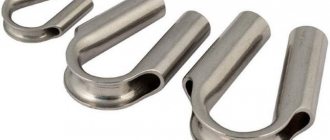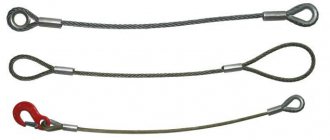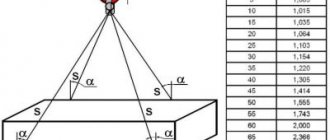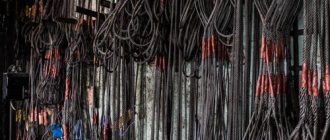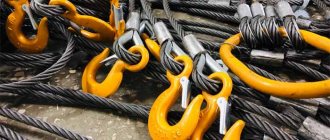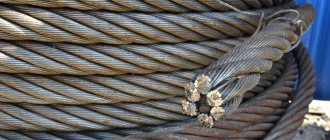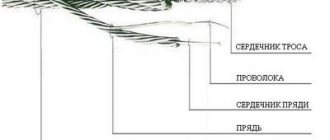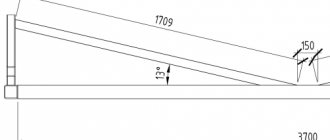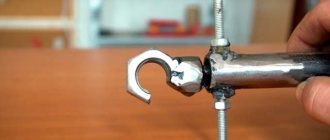To detect flaws, periodic use of flaw detectors is recommended. This tool is designed for:
- control of reduction in the diameter of the metal section,
- detection of internal and external corrosion,
- monitoring the formation of ruptures and wear of individual rope elements.
Increased care is needed when checking sections of the cable in the following places:
- fastenings,
- contact with movable and fixed blocks of the structure,
- fixing the greatest wear of internal elements,
- at the ends of the product.
A complete assessment of the condition of the sling is possible using several different methods, presented:
- an indirect method that involves calculating angular and linear damage to the structure of the product;
- visual assessment of the integrity of visible elements by a specialist;
- flaw detection of damage due to exposure to ultrasonic, x-ray and magnetic radiation;
- instrumental measurement of values of straightness, wear of wires, diameter of the cable section.
Features of cable condition monitoring
In accordance with the requirements of the governing document RD ROSEK 012-97, regardless of where the steel cable (not rope) is used, it must be checked before the start of each work shift. A detailed assessment of the condition must be carried out at least once every 10 days.
Defects must be detected through the use of flaw detectors. Their purpose:
- exercise control over maintaining the diameter of the metal section specified in the passport;
- detect the presence of external and internal corrosion;
- detect the break of one or more rope elements.
Steel material
Increased requirements are placed on compliance with steel rope rejection standards in the following places:
- where fastenings are made;
- where the rope comes into contact with fixed and moving structural elements;
- at the ends of the cable.
For a full assessment, several different options are used:
- an indirect method in which linear and angular damage to the rope structure is calculated;
- visual assessment. Allows you to determine the safety of visible surfaces;
- flaw detection using magnetic, x-ray and ultrasonic radiation;
- instrumental measurement. Allows you to identify the degree of wire wear, changes in cable diameter, and changes in straightness values.
Rope driving mechanism: basic assessment
Features of the rejection method
When should ropes and slings be inspected: frequency
When rejecting steel ropes, the number of broken wires is counted over a length equal to 30d or 6d (d is the designation of the rope diameter). This is done at the points of contact of the cable with the equalizing blocks, at the end seals and at the points where a break is detected. The permissible quantity, in the presence of which operation can continue, is established by Gosgortekhnadzor and is displayed in the table below:
Table
Note! The letter n denotes the number of supporting wires located in the outer strands, and d is the diameter of the cable. This is all determined by a special machine.
Determination of rope winding pitch
A parameter such as the lay pitch of a cable or rope is very important when considering the issue of rejection. The fact is that the number of breaks in thin fibers is usually calculated over a rope length equal to this pitch.
If there is no experience in carrying out such work, then difficulties may arise. Although in reality everything is quite simple. The pitch will depend on how many strands are in the rope. Next, a mark is made on the surface of one of the strands with a marker or center punch. All that remains is to count the number of strands in the cable one to the right or to the left and put a second mark. The distance between the two marks will be equal to the lay pitch. And it is precisely in this interval that the number of breaks must be counted.
Criteria for assessing the degree of wear of steel cables
Fire hydrants: norms and regulations, brands, sizes, requirements
When determining the safety of rope operation, the following criteria are used:
- the number of cliffs and their nature. Calculations are made on a certain section of the cable;
- are there places where wire breaks are concentrated;
- degree of internal and surface wear;
- the presence of corrosion, both internal and external;
- when one or more wires of the outer layer come out of the lock (applies to ropes of a closed structure);
- breaking of several or even one strand;
Rope mechanism - strength test
- reducing the diameter of the cable in one place;
- the cross-sectional area indicator decreases;
- the presence of basket-shaped and wavy deformation, as well as crushing and extrusion of strands;
- detection of damage resulting from exposure to high temperature or electric arc;
- lay parameters have been changed;
- the intensity of residual elongation changes.
Crane rope rejection
Crane ropes should be rejected if examination shows that the deterioration of the rope has exceeded certain criteria. General rejection criteria require that any one of the factors listed below is sufficiently serious to cause negative consequences. However, the deterioration of the rope and the decision to remove it are almost always the result of the cumulative effect of a combination of these factors: - wire breaks; — reduction in diameter; - deformation; — corrosion.
How to assess the condition of the cable core (its property)
Service life of workwear: standards
Based on the standards for rejecting steel ropes, they can be considered faulty even in the absence of external damage. This happens if flaw detection reveals damage to the core. The rope is considered unsuitable for use if the inspection reveals more than 18% loss of wires of the internal part.
Note! Not every enterprise has such equipment, as well as specialists to service it. And this is normal, because there is no need to constantly check the sealed parameters of the core. These tests are only required for products that must meet very high safety requirements.
In production
What are the ways to detect defects?
The most accessible, simple and cheap way to determine the rejection rate of steel rope slings is the visual method. An external inspection carried out by an experienced specialist using simple auxiliary equipment will allow timely detection of critical damage to the rope strands and take measures to prevent an emergency or accident.
In second place in popularity and effectiveness is the so-called instrumental method of establishing compliance with the standards for rejecting slings made of steel ropes. As research and experimental work have shown, by the nature of straightness and violation of the geometric shape in the cross-section of the cable, one can quite accurately predict its useful life. Not every engineer can do this kind of work. Here you need to have a powerful mathematical apparatus and appropriate instrumental support. Currently, highly specialized software packages have appeared on the market that allow partial automation of routine mathematical calculations. However, the cost of the license is very high, and its acquisition is unlikely to be economically feasible.
Features of the rejection method
A rope may be rejected even if it appears completely normal under the following conditions:
- there was a decrease in diameter by 7% (surface wear or corrosion);
- it was revealed that the diameter of the rope decreased by 10% or more (wear of the internal part, ruptures or bends);
- The rope is considered defective if the original diameter of the outer wires has become smaller by 40% or more. It does not matter whether this was due to corrosion or wear. To take measurements, it is recommended to use a micrometer or its equivalent, which allows for accurate measurements.
The rope cannot be used if the following defects are found in it:
- one or more strands are torn;
- there is a basket-shaped deformation;
- the core is extruded onto the outer surface;
- a place with a reduced or increased diameter has been identified;
- creases, crushed areas, twisting, and bends were found.
If blocks are used to operate the channel, the stream of which is lined with synthetic materials, or made entirely of them, then the destruction of the rope from the inside is considered characteristic when the outer layer is intact. In this case, flaw detection of the entire length of the cable is performed. If losses exceeding 17.5% are detected, the rope is removed from service.
Checking for damage
Rope technical inspection and replacement criteria
In accordance with the ISO 4309 standard, the operational safety of the rope is confirmed by an accurate assessment of the following indicators: - the number of wire breaks and their position; — wear of wires (reduction in rope diameter); — internal and external corrosion; — damage (defects) and wear of the rope.
Broken wire rope
It is necessary to count the number of wire breaks visible on the surface of the rope. In this case, you need to inspect the worn part of the product with special attention. Wire breaks must be monitored in sections of the rope equal to 6 and 30 rope diameters. If the number of wire breaks exceeds the established minimum on at least one of the two specified lengths, the rope must be replaced. Broken wires in a strand usually indicate internal damage to the rope. If the wire breaks, the broken ends should be clearly visible. A rope is considered for rejection if the number of visible broken wires is equal to or greater than the acceptable limit. In 6 and 8-strand ropes, wire breaks occur mostly in the outer layers, while in multi-strand ropes, wire breaks are typical in the inner part. These cliffs are invisible and require special research methods. It is recommended to replace the rope when the broken wires are close to each other at a length of no more than 6d or on the same strand.
Reducing rope diameter
When conducting a technical inspection to replace a steel rope, it is important to pay attention not only to the number of wire breaks. Flattening of the wires due to wear precedes the inevitable breakage. It is necessary to carefully inspect the wires, the diameter of which has visually decreased by approximately 50% compared to the initial state. The diameter of the rope may decrease due to one or a combination of these factors: - internal wear; — external wear due to abrasion of the outer wires; — deterioration of the core (organic/metal) or inner layers of multi-layer torsion-resistant (non-torsion) ropes. The rope must be rejected: - if the decrease in rope diameter exceeds 7% of the nominal rope diameter, only due to external wear; - if the decrease in rope diameter exceeds 3% of the nominal diameter of the non-rotating rope and exceeds 10% for other 6 and 8 strand ropes, due to reasons other than external wear.
Corrosion of ropes
Rope corrosion can be external or internal. External corrosion can be detected visually on the outer surface of the wire rope. Assessing internal corrosion requires specific professional competencies. To open the rope, grippers are used, with the help of which the product is carefully untwisted. In cases with multi-layer ropes and ropes with a metal core, only the outer layer is inspected. The rope must be rejected: - weakening of the wire due to corrosion of the external wires; — confirmation of severe internal corrosion.
Rope deformation
A permanent change from its original shape and orientation is called deformation. The following general changes in shape require immediate rejection of the steel rope: - local violation of the rope; - protrusion of wire, strand or core; - formation of twists or loops; — localized increase in diameter of more than 5% of the actual diameter of the rope; — Localized decreases in rope diameter and lay distance are associated with hard waviness.
Defects in steel rope
Criteria for rope damage and replacement
| Breaks and displacement of wires in two strands of a cross lay rope. The rope must be replaced. |
| Severe wear and a large number of wire breaks in the cross lay rope. Urgent replacement of the rope is required. |
| Wire breaks in one strand and slight wear of the parallel lay rope. It is necessary to remove broken wires and make the rope smooth. |
| Wire breaks in several strands located close to the idler pulley (sometimes pulled by the pulley). The rope must be replaced. |
| Wire breaks in two strands due to bending fatigue and severe localized wear. The rope must be replaced. |
| A birdcage defect in a multi-layer (low-twist) rope caused by excessive rotation around small grooves or too large a deviation angle. Urgent replacement of the rope is required. |
| Protrusion of the steel core, usually caused by lantern-type deformation. Urgent replacement of the rope is required. |
| Loosening of the wires of an individual strand. When examining a section of rope, deformation is observed at regular intervals, usually equal to the lay pitch. This defect must be monitored. |
| A more serious example of the previous defect with protrusion of the internal wires of the strands. Large localized defect caused by impact loads. Urgent replacement of the rope is required. |
| Local increase in the diameter of a parallel lay rope caused by deformation of the metal core under the influence of dynamic loads. The presence of traces of corrosion and severe wear of the outer wires. Urgent replacement of the rope is required. |
| A large knot causing protrusion of the organic core. Urgent replacement of the rope is required. |
| Rope that has been twisted during installation and use, subject to localized wear and strand pulling. The rope must be replaced. |
| Local decrease in rope diameter due to the tendency of external strands to fill the volume of the destroyed organic core. Urgent replacement of the rope is required. |
| Flattening of a section of rope caused by local destruction due to mechanical stress; this defect causes a lack of balance in the strands. There are also wire breaks. The rope must be replaced. |
| Flattening of a section of a multi-strand rope caused by mechanical impact on a large section of rope due to improper unwinding from a winch. The presence of an increased lay pitch of the outer strands with asymmetric stretching under load. The rope must be replaced. |
| Strong bend. The rope must be replaced. |
| The rope coming out of the pulley groove with subsequent deformation, flattening, local wear and multiple wire breaks. The rope must be replaced. |
| The cumulative effect of several factors. Excessive wear of the outer wires, which caused weakening of the wires and “lantern” type deformation; risk of the rope being pushed out of the pulley. Urgent rope replacement required |
Continuation
Wide range of steel rope (cable). There is a system of discounts for regular customers and wholesale buyers. For more detailed information, please contact our specialists.
Delivery within the Russian Federation: Moscow, St. Petersburg, Arkhangelsk, Astrakhan, Barnaul, Belgorod, Bryansk, Vladimir, Volgograd, Vologda, Voronezh, Yekaterinburg, Ivanovo, Izhevsk, Yoshkar-Ola, Kazan, Kaluga, Kirov, Kostroma, Krasnodar, Kurgan, Kursk, Lipetsk, Omsk, Orel, Orenburg, Penza, Perv, Pskov, Rostov-on-Don, Ryazan, Samara, Saransk, Saratov, Sevastopol, Simferopol, Smolensk, Stavropol, Tambov, Tver, Tomsk, Tula, Tyumen, Ulyanovsk, Ufa, Chelyabinsk, Yaroslavl, etc.
>Rejection standards for steel ropes – when is it urgent to change the rope?
Norms for rejecting slings
When producing slings, they are guided by standard 25573-82 and RF-10-33-93. In this case, each of the three stages of inspection is performed:
- interior;
- instrumental;
- outer.
When conducting an audit, special attention is paid to the following aspects:
- there are no discrepancies between the data specified in the product passport and its actual condition;
- presence and serviceability of loops at the ends of the rope;
- the presence of damage or defects on the surface of the cable;
- what condition are the internal strands and core in?
The rejection and inspection of slings is carried out by engineering and technical workers who are authorized to check the serviceability of the equipment and are responsible for the safety of the work. To record the results of the inspection, a special journal is created, designed in accordance with the requirements. It is registered with Gostekhnadzor. Its pages reflect the facts of detection of defects and the facts of their elimination, and also contain rules for storing synthetic ropes and slings.
Steel slings at the enterprise
Special rejection standards
If a metal rope is used to propel vehicles with people or to transport potentially dangerous and dangerous goods (acids, straightened metal, etc.), then the safety requirements, of course, become stricter, and the rejection rate is reduced exactly by half. That is, if a rope with forty fiber breaks per step length is usually considered defective, then in this case a rope with 20 breaks is already removed from service.
Special techniques are also used when deciding on the rejection of ropes twisted from thick wire. The fact is that domestic enterprises for the production of steel ropes produce two types of products: from thin wire and from thicker ones. It is clear that breaks in thick and thin rolled products cannot be equivalent. Therefore, when calculating the number of breaks in a thick wire per length of twist pitch, one break in a thick wire is equivalent to 1.7 breaks in a thin wire. The total number of defects should not exceed 40.
